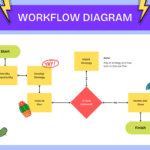Now Reading: How to Build a High-Performing Content Workflow
-
01
How to Build a High-Performing Content Workflow
- Home
- Tutorials
- Tech Tutorials
- How to Build a High-Performing Content Workflow
How to Build a High-Performing Content Workflow
![]() RoundNicheProductivity, Tech Tutorials2 weeks ago8 Views
RoundNicheProductivity, Tech Tutorials2 weeks ago8 Views

A strategic content workflow has become an essential framework for driving productivity and maximizing the effectiveness of content production. A content workflow refers to the structured process that outlines how content is planned, created, reviewed, and published. As businesses face increasing competition, the importance of having a well-defined workflow cannot be overstated. Without it, marketers often encounter challenges such as missed deadlines, inconsistent messaging, and ineffective content strategies.
The contemporary digital environment demands agility and responsiveness from marketers. This is particularly evident as consumer preferences shift and new platforms emerge. Implementing productivity tools to streamline the content workflow can significantly enhance a team’s ability to produce high-quality materials efficiently. These tools assist in automating repetitive tasks, facilitating collaboration, and ensuring that all team members stay aligned with their objectives. As a result, businesses can reduce the time from ideation to publication, thereby gaining a competitive edge.
Moreover, traditional approaches to content creation often lead to bottlenecks, diminishing the overall effectiveness of marketing efforts. A ad-hoc process can result in wasted resources and a lack of measurable outcomes, leaving marketers feeling overwhelmed. Conversely, a strategic content workflow mitigates such issues by offering a clear roadmap that aligns with business goals and audience needs. By fostering an organized environment, marketers can ensure that each piece of content serves a purpose and contributes to overarching objectives.
In light of these considerations, this guide aims to provide valuable insights on constructing a high-performing content workflow tailored to today’s digital demands. Implementing these practices will empower marketers to navigate the complexities of content production with increased confidence and proficiency.
Understanding the Latest Trends in Content Workflows
The advancements in technology and shifting creator demands. An analysis of data from Google Trends reveals several key insights into the latest strategies and productivity tools gaining traction among content creators. The most notable trend is the increasing reliance on artificial intelligence (AI) automation to enhance efficiency and improve content quality.
AI-powered tools are now at the forefront of content creation and management, providing streamlined solutions that help creators generate ideas, optimize content, and analyze performance. Platforms utilizing AI capabilities, such as natural language processing and machine learning, enable users to understand audience preferences better and adapt their content workflow accordingly. This suggests a growing trend towards customized content, where personal relevance drives engagement.
Additionally, productivity platforms are gaining momentum, emphasizing collaboration among teams, including remote contributors. Tools designed for project management and team communication are now integral to content workflows, allowing for seamless collaboration in the rapidly changing digital environment. The shift to these platforms not only boosts productivity but also ensures that content quality remains high, as feedback loops are established more effectively.
Furthermore, specific blogging tools designed for optimizing SEO and enhancing user experience are becoming increasingly important. These tools aid writers in refining their content strategy, enabling creators to identify trending topics and optimize their writing for search engines. Consequently, the content produced is more aligned with audience interests and search behavior.
The current trends show a distinctive movement towards integrating sophisticated technology into content workflows. By understanding these emerging patterns and the tools that facilitate them, creators can enhance their productivity and the overall quality of their output, positioning themselves for success in the competitive digital space.
Step-by-Step Workflow Framework for Content Creation
Establishing a high-performing content workflow requires a systematic framework that encompasses the entirety of the content creation process. This process typically involves five key stages: planning, creation, editing, publishing, and measuring success. Each stage plays a crucial role in enhancing productivity and ensuring that the final output meets the desired quality and objectives.
The first stage, planning, is foundational to an effective content workflow. During this phase, teams should outline their goals, target audience, and topics of interest. Utilizing productivity tools can aid in brainstorming sessions and organizing ideas. It is essential to create a content calendar that schedules when specific topics will be developed, ensuring a steady flow of content that aligns with marketing strategies and audience interests.
Next comes the creation phase, where the actual content is developed. Here, employing collaboration tools can streamline communication between writers, designers, and other contributors. This stage emphasizes creativity while adhering to predefined guidelines that maintain brand consistency. Crafting engaging and informative content is vital, as this enhances the reader’s experience and drives engagement.
Following content creation, the editing phase is crucial for refining the material. This involves reviewing the content for grammatical errors, ensuring clarity, and verifying that it aligns with the predetermined objectives. The use of editing software can significantly improve efficiency and accuracy, ultimately resulting in polished final pieces that resonate with the audience.
Once content is finalized, the publishing stage takes place. This step involves selecting the appropriate platforms and timing for distribution. Leveraging analytics tools can help determine when to publish content to maximize reach. The final stage, measuring success, consists of tracking key performance indicators (KPIs) such as engagement rates and conversion metrics. This analysis is essential for understanding the effectiveness of the content workflow and informs future iterations for continuous improvement.
Top Tool Recommendations to Optimize Your Content Workflow
Creating an efficient content workflow is integral to maximizing productivity and ensuring quality output. To assist in achieving this objective, we have compiled a list of highly recommended tools, each designed to enhance specific stages of the content workflow. These productivity tools not only streamline processes but also foster collaboration and creativity among team members.
1. **Trello**: Trello is an intuitive project management tool that allows for visual organization. Its card and board system makes it simple to track tasks at various stages of the content workflow, from ideation to publication. Team members can assign tasks, set deadlines, and add comments, facilitating smooth communication and progress tracking.
2. **Grammarly**: This tool is a must-have for any content creator aiming to maintain high writing standards. Grammarly offers real-time grammar and style checking, helping to optimize the quality of content before it reaches the editing phase. Its integration features with various platforms enhance the workflow by providing immediate feedback on writing quality.
3. **Canva**: Visually engaging content can significantly boost engagement. Canva offers a user-friendly design interface, allowing users to create stunning graphics and presentations for their content. With its extensive library of templates and resources, teams can collaborate in crafting professional visuals that complement their written materials.
4. **Slack**: Effective communication is critical in any content workflow. Slack provides a robust platform for team discussions, file sharing, and updates, ensuring that all members are aligned throughout the content creation process. Its integration capabilities with other productivity tools further enhance its utility in maintaining workflow coherence.
5. **Asana**: Asana is another project management tool that excels at helping teams streamline their content operations. With customizable workflows, task assignments, and an overview of project milestones, users can maintain clarity and focus throughout the content production lifecycle.
By leveraging these tools, organizations can optimize their content workflow, enhance productivity, and ensure that their creative efforts are systematic and successful.
Leveraging AI Automation Techniques in Content Creation
As the digital landscape continues to evolve, leveraging AI automation techniques has become essential in building a high-performing content workflow. The integration of these technologies not only improves efficiency but also enhances the overall quality of content produced. One major benefit of automation is the significant time savings it offers, allowing content creators to focus on higher-level strategic activities rather than mundane tasks.
AI tools have advanced remarkably and can assist significantly in various stages of the content creation process. For instance, tools like Grammarly and Hemingway Editor provide real-time feedback on writing quality, helping to enhance clarity and engagement. Furthermore, platforms such as BuzzSumo analyze trending topics based on social media engagement, guiding content teams on what resonates with their audience. These productivity tools empower creators to strategically align their work with audience interests and current trends.
Moreover, AI-driven content generation tools, such as Writerly and Copy.ai, can generate written content based on given prompts. This can serve as a starting point for creators and significantly expedite the drafting process. In a world where speed is crucial, having access to these tools can dramatically enhance productivity. Additionally, utilizing AI for content analysis allows teams to measure performance and adjust strategies in real-time, ensuring continuous improvement within the content workflow.
For instance, a marketing agency incorporated AI tools into its content workflow and reported a 40% increase in output quality while reducing production time. This real-world application underscores the effectiveness of utilizing AI automation techniques. By blending these innovative tools and traditional creativity, businesses can develop a streamlined and efficient approach to content creation.
Common Mistakes to Avoid When Building Your Content Workflow
Establishing an effective content workflow is crucial for any marketing team seeking to streamline their processes and maximize productivity. However, several common pitfalls can hinder this endeavor, leading to inefficiencies and subpar outcomes. One significant mistake is the lack of proper planning. Without a clear strategy in place, teams may find themselves reacting to ad hoc requests rather than following a structured approach. This reactive mode can result in missed deadlines, inconsistent messaging, and ultimately, wasted resources.
Another frequent error is inadequate tool integration. Many teams utilize various productivity tools, but failing to ensure these tools work synergistically can create confusion and slow down the content creation process. For example, using disparate platforms for project management, content creation, and analytics without proper integration can lead to information silos. A seamless content workflow requires that these tools communicate effectively, allowing teams to manage projects, collaborate efficiently, and track performance metrics without friction.
Moreover, neglecting to measure results presents another critical drawback. Establishing metrics to evaluate the effectiveness of content efforts is essential for long-term success. Without data-driven insights, teams are left in the dark regarding what strategies are working and which need adjustment. It is vital to engage in regular reviews and assessments of content performance, allowing for informed decision-making and continuous improvement in the content workflow.
By addressing these common mistakes—insufficient planning, poor tool integration, and a lack of measurement—marketers can enhance their content workflows substantially. Avoiding these pitfalls will not only facilitate a more streamlined production process but also improve overall content quality, leading to better engagement with target audiences.
Measuring Success: Key Metrics for Content Workflow Efficiency
To optimize a content workflow, it is imperative to measure its success through distinct and relevant key performance indicators (KPIs). These metrics serve as benchmarks, enabling teams to assess efficiency and effectiveness in reaching established content objectives. One crucial area to consider is user engagement, which can be measured through metrics such as comments, shares, and likes on various platforms. High engagement levels often indicate that the content resonates well with the audience, highlighting the effectiveness of the content workflow in producing valuable material.
Another significant metric is traffic, which reflects the number of visitors to your content. This can be monitored using tools such as Google Analytics, which allow content teams to analyze both the quantity and quality of traffic driven to their website or specific content pieces. Tracking unique visitors, page views, and session durations helps identify which content pieces are performing well and which may require adjustments in strategy or presentation.
Conversions are perhaps the most critical metric in demonstrating the impact of a content workflow. Whether the desired outcome is newsletter sign-ups, product purchases, or lead generation, tracking conversion rates allows organizations to gauge how effectively their content drives action. It’s essential to use tools that can streamline the measurement of these conversions, aligning with productivity tools that automate and visualize data collection and reporting.
To set up an effective measurement system, teams should first align their KPIs with specific content goals. This entails defining what success looks like for each piece of content, whether it is increased brand awareness, audience engagement, or driving sales. By establishing clear objectives, teams ensure that their measurement system is focused and strategically implemented. Incorporating these metrics into regular reporting will foster a cycle of evaluation and improvement, ultimately enhancing overall content workflow efficiency.
Evolving Your Content Workflow
In the rapidly changing digital landscape, organizations must prioritize the continuous improvement of their content workflow to maintain relevance and maximize effectiveness. As market demands shift and new technologies emerge, failing to adapt can result in lost opportunities and diminished productivity. To ensure that your content operations remain competitive, it is essential to implement a systematic approach for regular review and adjustment of processes, guided primarily by performance data and emerging trends.
One effective strategy for achieving ongoing enhancement is to establish a routine evaluation schedule, incorporating performance metrics that measure key aspects of your content workflow. This may include content engagement rates, conversion metrics, and audience feedback. Regular assessments not only reveal areas of success but also highlight bottlenecks or inefficiencies that can be addressed. By leveraging productivity tools that provide data analytics, teams can quickly pinpoint which segments of their workflows require adjustment and implement necessary changes promptly.
Another aspect of fostering continuous improvement is encouraging a culture of adaptability within your team. This mindset stimulates innovation and empowers team members to propose new ideas or tools that can augment your content workflow. For instance, experimenting with automation technologies or collaborative platforms can streamline processes and enhance collaboration. Emphasizing an open dialogue about obstacles and adaptations within the content creation process allows for ongoing development and learning.
In conclusion, the evolution of your content workflow should be seen as an ongoing journey rather than a final destination. By committing to regular assessments, embracing new technologies, and fostering a culture of adaptability, organizations can not only improve efficiency but also enhance the quality of their content, ensuring they remain competitive in a dynamic marketplace.
Empower Your Content Strategy with a High-Performing Workflow
In today’s digital landscape, establishing a high-performing content workflow is essential for any organization looking to optimize its content strategy. A well-defined workflow streamlines the content creation process, allowing teams to allocate resources effectively and elevate productivity levels. By embracing productivity tools such as project management software, collaborative platforms, and comprehensive content calendars, organizations can enhance their operational efficiency and ensure that deadlines are met without sacrificing quality.
Throughout this guide, we have highlighted several key components crucial to developing a robust content workflow. First, the importance of clear communication among team members cannot be overstated. Utilizing communication tools fosters collaboration and aligns objectives, which leads to improved content quality and cohesiveness. Next, the role of strategic planning is fundamental. By outlining clear goals and identifying target audiences, content creators can tailor their efforts to meet specific objectives, driving better results.
Moreover, leveraging analytics tools enables teams to assess the performance of their content effectively. The insights gained from these analytics can inform future strategies, allowing for continuous improvement and heightened audience engagement. When teams implement feedback loops and iterative processes, they cultivate an environment where creativity flourishes, leading to a consistent output of high-quality content.
As you reflect on these practices, consider taking actionable steps to enhance your content strategy today. Explore the recommended productivity tools and techniques discussed, utilizing them as a blueprint to refine your content workflow. The result will not only yield increased productivity but will also foster higher-quality content, ultimately improving audience engagement and driving business success. Remember, a high-performing content workflow is not merely an aspect of your strategy; it is an invaluable asset that empowers your team and elevates your brand.
























